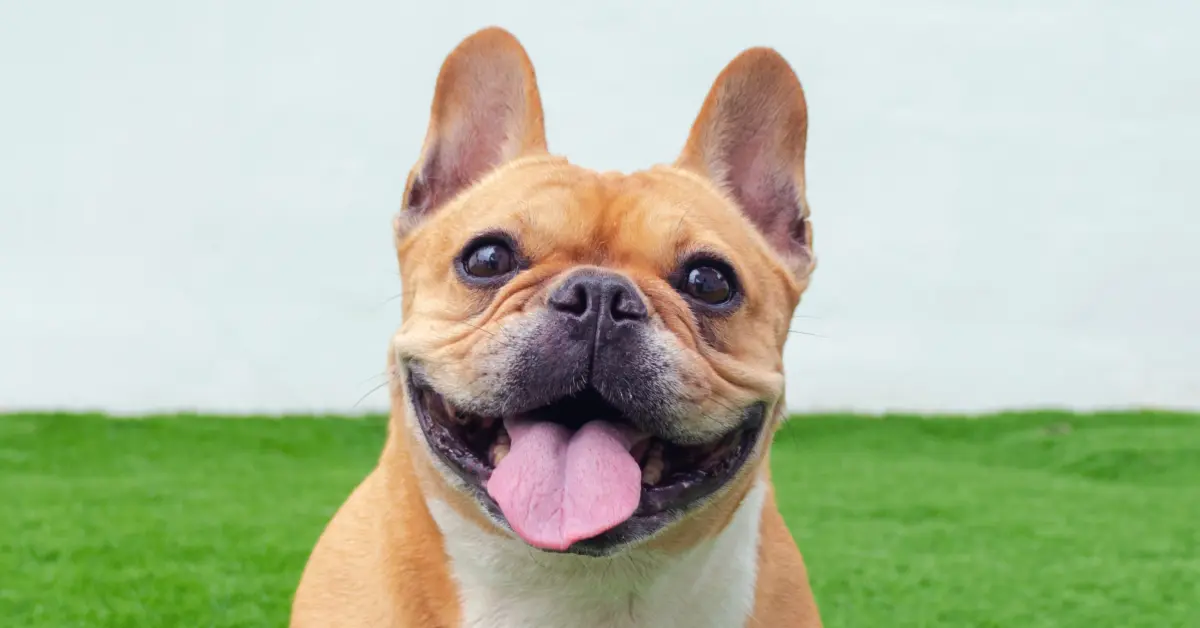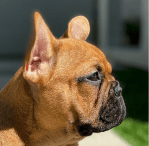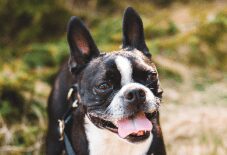
Meet the French Bulldog
Couch Cuddler
Pawfect Playmate
Best Fur Friend
If you’re looking for a fun-loving pup who loves to snuggle, I’m the doggo for you! I love to love and be loved, so I’m a great playmate for the whole fam – kids and fur siblings included. I’m a small dog (but I have a big heart!) so I would be pawfectly happy in an apartment. I don’t need lots of exercise, but I love my walkies and need them so I don’t get chunky. I do best with my humans around, so if you’re there for me, I’ll be there for you. I’m loyal and alert and would love to be your watchdog – nobody messes with my family! I love attention, so I’m easy to train if you start early (but I can be stubborn so be patient pawlease!).
Humans love my big bat ears and squishy face, but I’ll need your help to keep my skin folds clean (I promise it’s easy once you get the hang of it!). I hope you don’t mind snorting, snoring, and farting – I can’t help it, that’s just how Frenchies roll! And if you’re a first-time pup parent, don’t worry! I’m easygoing and low maintenance, so I’d love to be your first dog.
Ready to learn more about me? Let’s dig in.
Ready to learn more about me? Let’s dig in.
 My Many Looks
My Many Looks

Brindle

Cream

Fawn

White
 My Breed Characteristics
My Breed Characteristics
 Furbulous Fact
Furbulous Fact
Though we French Bulldogs are not traditionally used as service dogs, one brave Frenchie provided his services to the United States Army in World War I. Mutt was a French Bulldog who was used as a delivery dog, bringing supplies to soldiers in the trenches. Perhaps more importantly, Mutt provided brief but morale-boosting moments of comfort and companionship to the servicemen on the front lines. Mutt was injured twice during the war, but he survived and returned to the United States as a war hero, making all us Frenchies proud.
 As I Grow Up
As I Grow Up
As you can see, we Frenchies age pretty gracefully. Here are a few key milestones in my growth & development to be aware of as I grow up from a pupper to an adult and senior!

Puppy4 Months
It’s impawtant to start my obedience training and socialization when I’m a pup. I can have trouble breathing because of my face shape, so let’s avoid long outdoor training seshes.

Adult1.5 Years
I’m a grown-up, well-adjusted companion now, but keep an eye on my weight (I’m prone to obesity). Avoid overfeeding and people food, even if I try to guilt you with my sweet eyes!

Senior8-10 Years
As I age, I may start to develop problems with my joints, so you should limit my activity. I still want to snuggle with you on the couch or bed, but make sure I don’t jump on and off too much!
 History of My Breed
History of My Breed
Despite my name, my earliest ancestors came from England not France! In the mid-1800s, the toy Bulldog was a popular breed among the English people – especially the lace makers of Nottingham. When the Industrial Revolution caused many of their shops to close, the English lace makers moved to northern France with my loyal ancestors by their side. We were a hit among the French people, who started to breed my ancestors with other dogs, giving some of us the famous bat ears that our humans love so much. They named us Bouledogue Francais, and we were the talk of the town in Paris. The Parisians loved us so much that famous artists like Henri de Toulouse-Lautrec and Edgar Degas immortalized us in their artwork.
Wealthy Americans who came to France on holiday saw us with our fancy French families and fell in love with our big ears and expressive eyes – and that’s how us Frenchies made our way to the USA! Americans preferred my bat-eared ancestors (while the French Frenchie-lovers preferred the rose-shaped ears), so when Americans started to breed us, they kept the bat ears which became our breed standard. The French Bulldog Club of America was formed in 1897 – a whole year before we were even an AKC-certified breed! That just goes to show how quickly Americans fell in love with us Frenchies (and why we are still such a popular breed).
 Pawesome Pups to Parent
Pawesome Pups to Parent
In addition to purebred Frenchies like me, there are tons of pawfectly sweet mixed-breed French Bulldogs that are looking to find their furever homes. You can learn where to find your next pet below!
 Care Tips
from Veterinarians
Care Tips
from Veterinarians 
Choose a breeder who does genetic health screenings.
French Bulldogs can have genetic problems with their spines and hips, and making sure that a breeder has screened their dogs for genetic diseases is a good idea. - Michele King, DVM
Stay on top of any allergies or infections.
French Bulldogs are a brachycephalic breed, which means that they often have narrow nostrils and airways. Therefore, any illnesses that can affect their breathing – such as allergies or infections – need to be addressed immediately. - Erica M. Irish, DVM
Proper grooming is essential for good health.
In addition to regular brushing and baths, French Bulldogs require a little more upkeep. Because they have lots of skinfolds, it is important to keep these areas clean and dry to prevent infection. - Erica M. Irish, DVM
 Training Tips
from Trainers & Behavior Specialists
Training Tips
from Trainers & Behavior Specialists

Get your Frenchie used to being handled by humans.
Because French Bulldogs have flat faces (technically known as brachycephaly), it’s a great idea to get them used to being handled by humans in case they have health issues. With your vet’s permission, take them to the vet for happy visits in which they get treats and petting but nothing scary happens. When you first get your puppy, look for a puppy class that uses positive reinforcement to teach them to like handling and vet exams. - Zazie Todd, PhD
Make socialization & obedience training an early priority.
French Bulldogs can have a difficult time getting on with other dogs due to their unique build and appearance. If not properly trained and socialized, they can fall into bad habits and become bossy and demanding. In puppyhood, work hard to set boundaries with your Frenchie. Teach them basic cues and ensure they are properly socialized and trained with a solid recall. - Jen Jones, Certified Dog Trainer

 Why Get Dog Insurance?
from Pumpkin®
Why Get Dog Insurance?
from Pumpkin®
French Bulldogs are prone to certain health issues, and ruh-rohs can happen to any dog at any age. If your pup gets hurt or sick, pet insurance can help you say ‘yes’ to the best care, even when it’s costly. When it comes to shopping for this breed, you’ll want to choose insurance plans like Pumpkin's, which can help cover the costs associated with the hereditary conditions Frenchies are prone to developing. While a reputable breeder will conduct genetic testing on your pup’s parents to help minimize the chances of passing down hereditary conditions – they can’t always be avoided. Let’s look at some common ones, and how Pumpkin Dog Insurance plans could help cover the cost of care!
 BOAS
BOAS
Frenchies are a brachycephalic (“short-faced”) breed. The anatomy of their head, muzzle, and throat makes it difficult to breathe. Frenchies with severe Brachycephalic Airway Syndrome may require several surgeries, including soft palate resection and stenotic nares resection. Surgeries are not a forever fix, and these dogs may need additional treatment.
- Cost to Treat
- $1,200-$5,200 (surgical)
- Pumpkin Pays Back*
- $1,080-$4,680
 Cherry Eye
Cherry Eye
Cherry eye occurs when the third eyelid (nictitating membrane) becomes displaced. It is characterized by a red or pink swollen mass in one or both eyes. This is most common in younger dogs (4 months to 2 years). There are non-surgical and surgical options to correct cherry eye depending on the severity of the problem.
- Cost to Treat
- $1,200-$1,600 (surgical)
- Pumpkin Pays Back*
- $1,080-$1,440
 IVDD
IVDD
Intervertebral Disc Disease is caused when the cushioning discs between the vertebrae of the spinal column bulge and compress the spinal cord. This condition can cause severe pain, nerve damage – even paralysis. Milder cases can be treated non-surgically (steroid treatments, crating, and physical therapy), but in more severe cases surgery is preferred.
- Cost to Treat
- $1,500-$4,000 (surgical)
- Pumpkin Pays Back*
- $1,350-$3,600
 Patellar Luxation
Patellar Luxation
French Bulldogs are genetically predisposed to patellar luxation, an orthopedic condition where the kneecap (patella) is dislocated from its natural position in the groove of the femur (thigh bone). Patellar luxation can negatively affect mobility, and while some cases are mild, others are very severe and require corrective surgery.
- Cost to Treat
- $1,500-$3,500 (surgical)
- Pumpkin Pays Back*
- $1,350-$3,150
*Example illustrates reimbursement of a covered vet bill at a 90% reimbursement rate, where the annual deductible had already been satisfied and the annual limit had not yet been met. Coverage and reimbursement results vary based on policy options.




